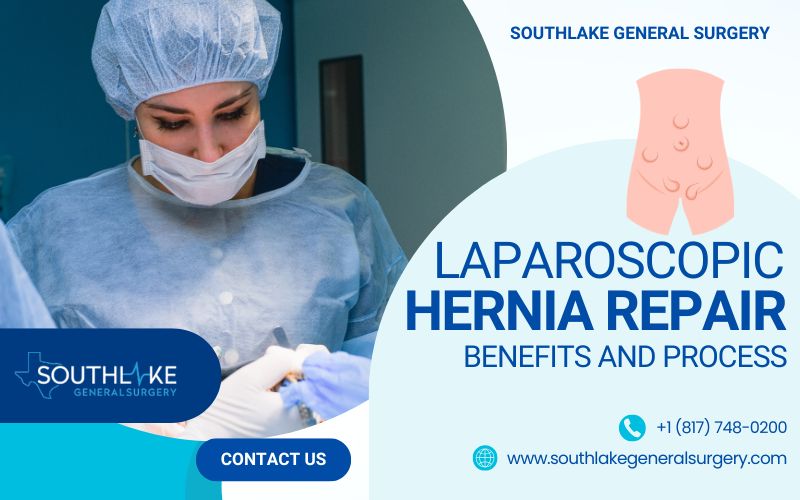Laparoscopic hernia repair is a new and improved way to fix hernias. This method uses small incisions, making it easier on the body and offering long-lasting relief for patients.
A thin tube, known as a laparoscope, is utilized in this procedure. It has several benefits over open surgery. Post-surgery, individuals experience less pain and heal more quickly.
Key Highlights
- Laparoscopic hernia repair offers a simpler alternative to open surgery.
- This technique involves smaller incisions, resulting in less pain and minimal scarring.
- Dr. Valeria Simone at Southlake General Surgery in Texas is skilled at laparoscopic hernia repair. She provides great care.
- This procedure is often used to treat both sides, repeated, or complicated hernias. It helps people heal more quickly.
- Dr. Simone has a lot of experience and pays close attention to her patients’ needs. This positions her as an excellent option for hernia repair.
Understanding Hernias and Laparoscopic Techniques

A hernia occurs when an internal organ or tissue pushes through a weak spot in the muscles or nearby tissue. This may result in a noticeable protrusion and could lead to pain or discomfort. Hernias can show up in various areas of the body, but they are usually found in the abdominal wall.
Laparoscopic surgery is a technique where doctors create small cuts in the body. They utilize specific tools and a camera to carry out the procedure. This method has many benefits compared to open approach surgery. It causes less harm to the tissue, which helps people heal faster than they would with open surgery.
What is a Hernia?
A hernia happens when there is a vulnerable area in the abdominal wall. This weak area allows things from the belly, such as a part of the intestine, to push out. You can imagine it as a weak area in a bag. When you press the bag, the stuff inside can push out through that weak spot.
When pressure builds up, a pouch can develop. This pouch is known as a hernia sac. It carries the organ or tissue that has moved from where it should be. You might feel a bump or lump beneath your skin. At times, this hernia is connected to the iliopubic tract.
Hernias can happen for several reasons. They may occur because of straining, heavy lifting, long-term coughing, or simply aging. Over time, these factors can weaken the abdominal wall.
Benefits of Laparoscopic Hernia Repair
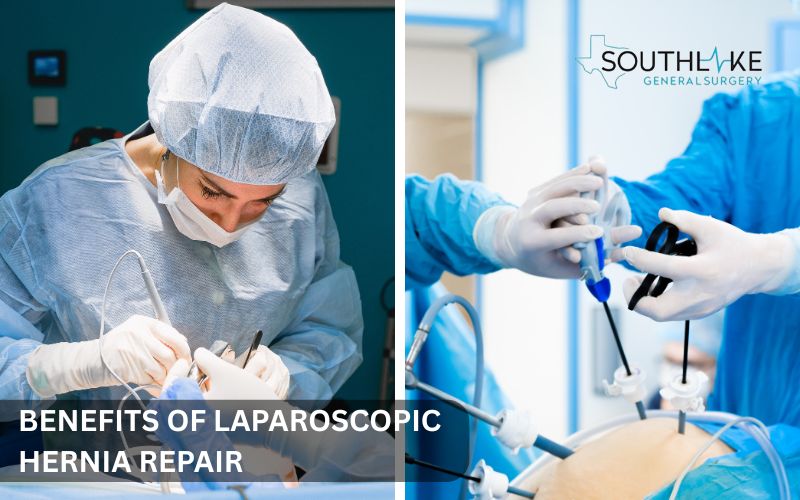
Laparoscopic hernia repair is a widely chosen method for many people. It offers numerous advantages over traditional open hernia repair surgery. One major advantage is that patients feel less pain after the surgery.
This method involves making several small cuts instead of one big cut. This approach minimizes damage to the tissue. This leads to a reduction in pain experienced by patients post-surgery. They also heal faster and can return to their daily activities more quickly. Smaller cuts make scars easier to cover. This is a big plus for many people.
Dr. Valeria Simone’s Expertise in Hernia Repair
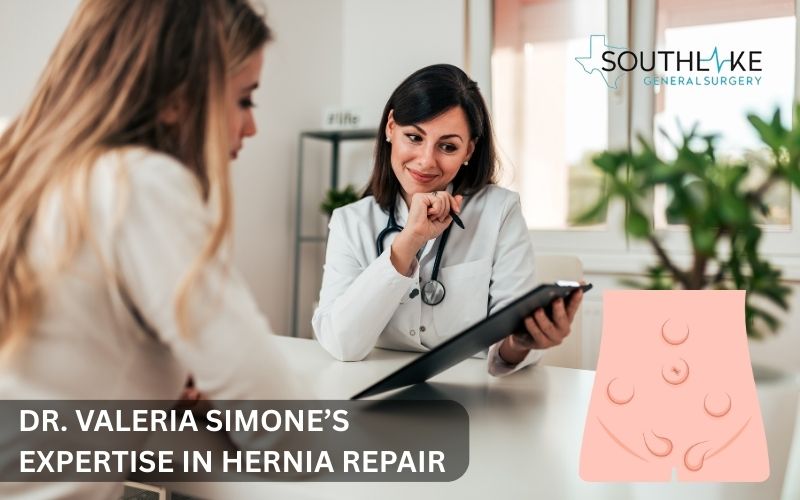
Dr. Valeria Simone serves as a board-certified general surgeon at Southlake General Surgery located in Texas. She focuses on modern laparoscopic hernia repair techniques.
Dr. Simone genuinely cares about her patients. She uses safe methods and is dedicated to achieving excellent surgical outcomes. She also strives to create a friendly and personalized environment for patients undergoing this procedure.
Her background and qualifications
Dr. Simone works hard to give great healthcare. She keeps learning and works with a skilled healthcare team. She stays updated on the newest ways to repair hernias. This enables her to provide the highest quality and most secure care for her patients.
Dr. Simone excels at each stage of the procedure. She looks after patients and prepares them for surgery. She employs the latest and most effective techniques and instruments for surgical procedures. She understands that each patient is different. This is why she makes treatment plans that fit their personal needs and wishes.
Dr. Simone is skilled at fixing hernias using laparoscopic techniques and general anesthesia. Her top priority is to ensure that patients feel comfortable and taken care of.
She works hard to communicate clearly. Dr. Simone spends time explaining the procedure, answering questions, and supporting patients throughout their surgery.
Why choose Dr. Simone for hernia repair?
Dr. Simone is good at using laparoscopic techniques. This helps her do surgeries that are more precise and easier on the body. This results in less pain for patients and minimizes the appearance of scars. It also helps them heal faster.
Dr. Simone is different because she cares a lot about her patients’ happiness. She pays close attention to each person and makes them feel at home.
In her practice, patients feel important and are listened to. Dr. Simone really hears their worries. She explains the steps in simple words. This instills a sense of calm and assurance in patients regarding their treatment choices.
She uses the newest methods and keeps up with the latest surgery techniques. This allows her patients to get the best, safest, and most advanced care.
Preoperative Considerations for Laparoscopic Hernia Repair
Before you have a laparoscopic hernia repair, there are some important things you need to consider. These points are essential for your safety and will help ensure the surgery goes smoothly. The first step is to undergo a thorough evaluation.
This check has a few steps. At the outset, the doctor looks over the patient’s records. Next, they do a physical exam. Finally, they run any tests that are needed. For optimal outcomes, ensure thorough preparation. Attention to detail is essential.
Patient assessment and preparation
Preparing the patient for surgery is an essential aspect of preoperative care. Reviewing the patient’s health records is the first step. This includes gathering information about any health problems, allergies, previous surgeries, and the medications they are currently taking.
Next, you will have a full physical exam. The healthcare provider will check your hernia. They will see how big it is and where it is located. They will also examine the tissues and blood vessels nearby.
Sometimes, doctors must do more tests. Imaging methods such as MRIs, CT scans, or ultrasounds may be used for these examinations. They give more information about the hernia and nearby areas. A good checkup helps the surgeon make a better plan for the patient.
Types of hernias suitable for laparoscopic repair
Laparoscopic hernia repair is a good choice for inguinal and ventral hernias. Inguinal hernias are the most common type. They happen in the groin area. The laparoscopic approach and techniques work very well to treat these hernias.
This method can also fix ventral hernias in the abdominal wall. It requires a small cut. A mesh is used in the repair. This helps to make the weak spot stronger.
Laparoscopic surgery has several benefits. You will recover quickly after the procedure. You will feel less pain too. Plus, there is a lower chance that the problem will come back.
Many people pick this new method to treat hernias. It is quick and highly effective.
Step-by-Step Guide to Laparoscopic Hernia Repair
Laparoscopic hernia repair surgery, along with open inguinal hernia repair, necessitates meticulous planning, particularly in instances of bilateral inguinal hernias.
There are two main ways to perform this surgery: TAPP and TEP. The steps can change slightly depending on the method used and the patient’s needs. However, the basic procedures are usually the same.
These special methods help doctors repair hernias. They do this with minimal damage to the surrounding tissues.
Key surgical techniques used by Dr. Simone
Dr. Simone has two main ways to fix hernias: Transabdominal Preperitoneal (TAPP) repair and Totally Extraperitoneal (TEP) repair. Both of these methods use laparoscopic techniques to treat direct hernias on the anterior abdominal wall. Because of this, the operations are less invasive.
- In TAPP hernia repair, the surgeon enters the abdomen. They locate the hernia sac and then work on the front of the abdominal wall.
- In TEP repair, the surgeon creates a cavity behind the abdominal wall. They do this without going into the peritoneal cavity. This method can lower the chance of some complications.
Mesh fixation plays a crucial role in securing a hernia during laparoscopic surgery. It helps to make the weak abdominal wall stronger. Dr. Simone chooses the right surgical mesh and puts it over the hernia.
Doctor ensures it is secure to prevent any problems later. There are different ways to attach the mesh. They can use stitches, tacks, or special glues. The specifics of every case dictate the approach that is most appropriate.
Dr. Simone likes to use blunt dissection techniques during surgery whenever he can. He is careful and takes his time. He gently pulls apart tissues using special tools. This way causes less damage and supports healing.
Tools and technologies in advanced laparoscopy
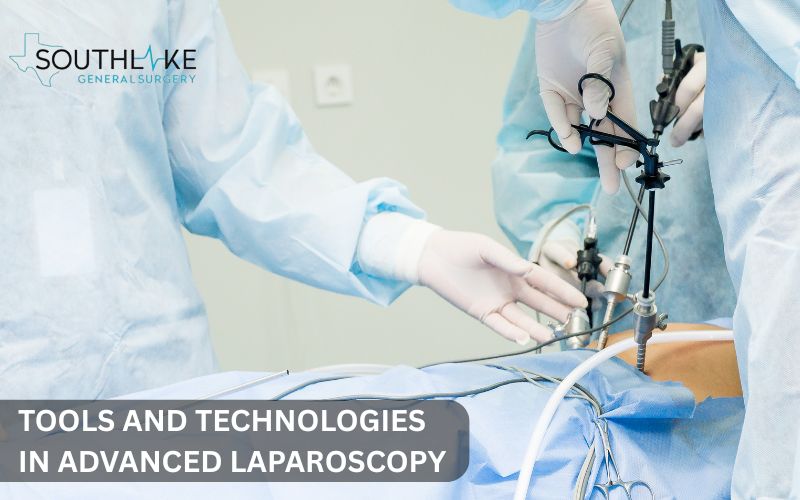
Advanced laparoscopy uses special surgical instruments and new technology. This helps doctors perform surgeries that are gentler on the body and offer better care. A key tool in this process is the laparoscope. It is a thin tube with a high-quality camera inside. This camera sends live images to a screen in the operating room.
Medical professionals utilize carbon dioxide gas to examine the abdominal cavity. They make a small cut near the belly button and put in tools while the patient is asleep under general anesthetic. The gas puffs up the area and separates the organs. During the surgery, they watch the gas and take it out when the surgery is done.
Thanks to better tools for laparoscopic surgery and skilled doctors like Dr. Simone, the hernia repair has improved a lot. Now, patients feel less pain while they heal and see great results.
Post-Operative Care and Recovery
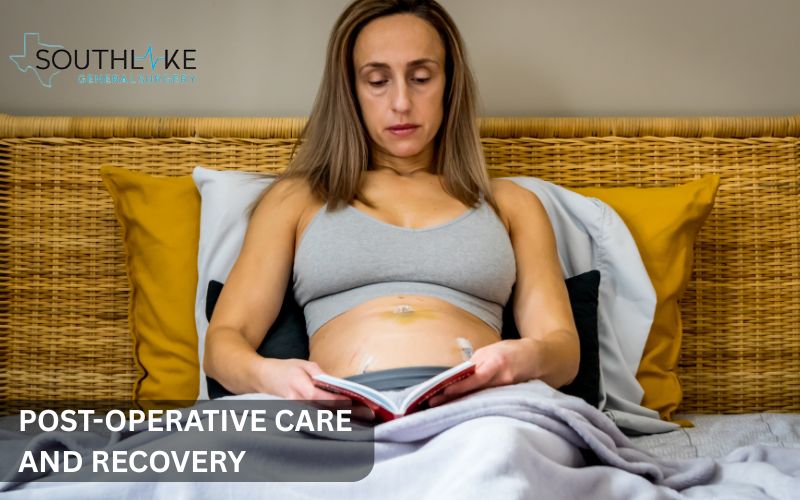
After a laparoscopic hernia repair, you should take care of yourself. Focusing on your recovery time can help you feel better. This can lead to less pain and will help you get back to your daily routine safely and slowly.
In the days following the surgery, monitor the patient attentively. If they feel pain, be there to help them. You can also share easy tips for them to take care of themselves at home.
Immediate post-operative care tips
After patients wake up from general anesthesia, the first thing to do is manage their pain and support their recovery. They begin by receiving pain relief through an IV. After that, they switch to taking oral medication to feel better.
After surgery, the first day matters a lot. Keeping the incisions clean and dry is very important. This is important to stop infections. Your healthcare team will give you instructions on how to take care of your wounds. They will inform you about when you need to change the dressings.
Some patients may notice swelling or clear liquid around their cuts. This is normal. However, if you notice significant swelling, redness, warmth, or if the fluid appears to be pus, it is important to contact your doctor immediately. It could mean you have an infection.
Long-term recovery and lifestyle adjustments
Recovery can feel fast at the beginning. However, fully healing takes time. Listening to your surgeon’s advice is essential. This will help you recover well later. Your surgeon may advise you to stay away from certain activities. This usually includes heavy lifting, which you should avoid for some time.
Take your time when you begin exercising again. Do what feels good for you. It is important to avoid hard activities or heavy lifting until your healthcare provider gives you the go-ahead.
Your body needs time to heal completely. By following these tips, you can prevent issues and help your recovery.
Conclusion
In conclusion, taking care of yourself at home after laparoscopic hernia repair is crucial for a successful recovery. Immediate post-operative care involves managing pain, keeping the incision sites clean and dry, and monitoring any signs of infection.
Long-term recovery requires following your surgeon’s instructions, avoiding heavy lifting, and gradually easing back into exercise. By prioritizing self-care and listening to your body, you can support your healing process effectively.
Make an Appointment
You can set up a meeting with Dr. Valeria Simone, MD. She is skilled in fixing hernias with laparoscopic techniques. Dr. Simone is at Southlake General Surgery in Texas, USA. To make an appointment, you can call +1 (817) 748-0200.
Her healthcare team uses advanced methods for hernia repair. This means you will recover faster and feel less pain after your surgery. Get in touch with us to book a consultation and learn more about our hernia treatments.
Frequently Asked Questions
How long is the recovery period after laparoscopic hernia repair?
The laparoscopic method for fixing a hernia helps you get better faster than open surgery. Each person experiences healing in their own unique way and at their own pace. If you follow the care tips from your healthcare team, you can feel better and recover properly.
What are the risks associated with laparoscopic surgery for inguinal hernia repair?
Laparoscopic hernia repair as a surgical procedure can come with risks and side effects, like any kind of surgery. These problems aren’t very common, but they can still happen. Some issues that may occur include bleeding, infection, or damage to blood vessels and nearby tissues.
Can hernia reoccur after lap hernia repair?
Laparoscopic hernia repair is a great option that offers a quicker recovery. However, there is a possibility that the hernia might return. This type of surgery is well-liked in the United States. Its success can be different for each person. Many things can affect this. These factors include the methods used during the operation. They also depend on the patient’s general health and how well they follow post-operative care instructions.
Medically Reviewed By: Dr. Valeria Simone MD
Board-certified General Surgeon at Southlake General Surgery, Texas, USA.
Follow us on Facebook and YouTube.
References:
- Fitzgibbons, R J., Camps, J., Cornet, D. A., Nguyen, N. X., Litke, B. S., Annibali, R, & Salerno, G. M. (1995). Laparoscopic inguinal herniorrhaphy results of a multicenter trial. Annals of Surgery, 221(1), 3–13. https://doi.org/10.1097/00000658-199501000-00002
- Koch, C. A., Greenlee, S. M., Larson, D. Harrington, J. R, & Farley, D. R. (2006, December 1). Randomized Prospective Study of totally Extraperitoneal Inguinal hernia Repair: Fixation versus no fixation of mesh. https://www.ncbi.nlm.nih.gov/pmc/articles/PMC3015750/
- Narayanan, C., More, M., Chattopadhyay, S., Kubendran, R, & Ravichandran, D. (2022). Fascia lata transabdominal pre-peritoneal repair in incarcerated inguinal hernia (FL TAPP) – A case report. International Journal of Surgery Case Reports, 96, 107308. https://doi.org/10.1016/j.ijscr.2022.107308
- Woo, K. P., Ellis, R. C., Maskal, S. M., Remulla, D., Shukla, P., Rosen, A. J., Wetzka, I., Osei-Koomson, W., Phillips, S., Miller, B. T., Beffa, L. R., Petro, C. C., Krpata, D. M., Prabhu, A. S., Lo Menzo, E., & Rosen, M. J. (2024). The association of permanent versus absorbable fixation on developing chronic post-herniorrhaphy groin pain in patients undergoing laparoscopic inguinal hernia repair. Surgical Endoscopy, 38(6), 3433–3440. https://doi.org/10.1007/s00464-024-10866-z
- Bittner, R., Leibl, B., Jager, C., Kraft, B., Ulrich, M., & Schwarz, J. (2006). TAPP – Stuttgart technique and result of a large single center series. Journal of Minimal Access Surgery, 2(3), 155. https://doi.org/10.4103/0972-9941.27730
- Shah, M. Y., Raut, P., Wilkinson, T., & Agrawal, V. (2022). Surgical outcomes of laparoscopic total extraperitoneal (TEP) inguinal hernia repair compared with Lichtenstein tension-free open mesh inguinal hernia repair: A prospective randomized study. Medicine, 101(26), e29746. https://doi.org/10.1097/md.0000000000029746

